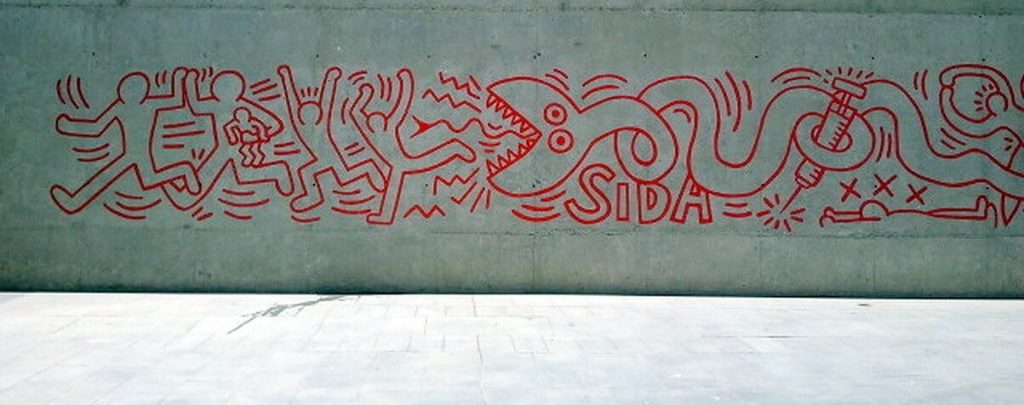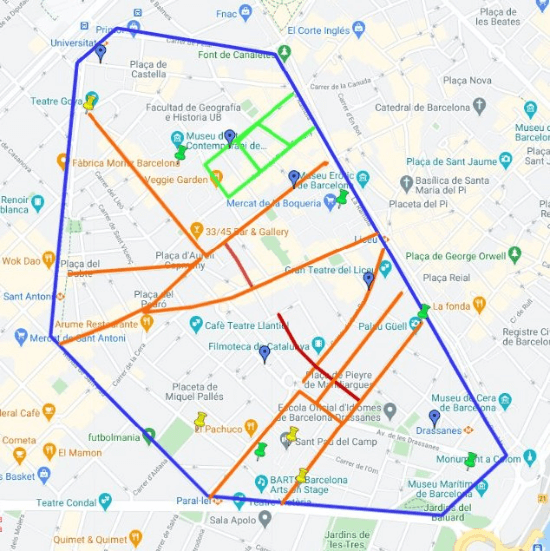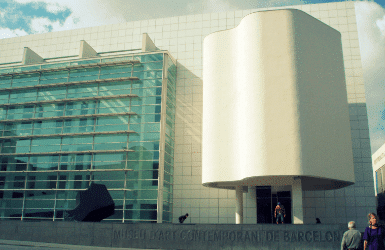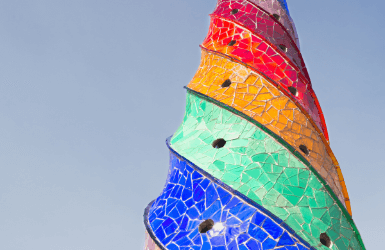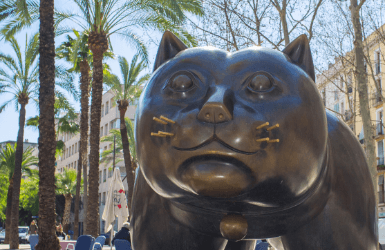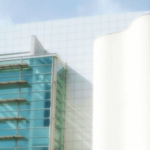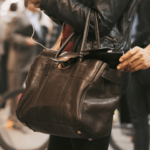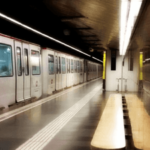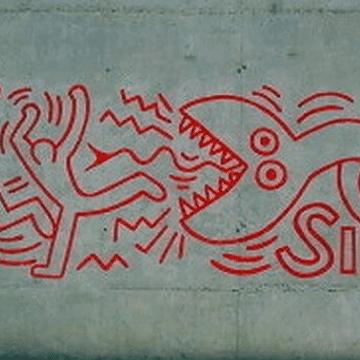
Barcelona Raval District: Safety & Sites To Visit
RAVAL BARCELONA WILD DISTRICT
El Raval is the district of the Barcelona Old Town located East of La Rambla, mainly between La Rambla and the Poblesec and Sant Antoni districts. Originally it was a land of farming and facilities that didn’t fit in a tight walled city (and that locals preferred away from them), such as orphanages and hospitals. But eventually it became the last part of the medieval area to be enclosed by walls.
The Olympic Games in 1992 were the excuse to start working in the area. Entire sections of the district where demolished (and the badly planned expropriations broke havoc among the many sublessees without contracts in place, sending them to misery). The Barcelona University was invited to move some faculties in, knowing that students have the power to rejuvenate the atmosphere of a district. A contemporary museum was built. A wide boulevard with palm trees along it was open.
The project worked only up to a certain point, and much more slowly than they thought. Drugs are not the wild problem they used to be in the 80’s and 90’s… but they are still around. There are no more red lights everywhere in the district… but there are some particular streets where the night ladies call out for clients in the streets. The proximity of the 2 new police stations hasn’t stop pickpockets from being active in the area.
Yes, La Rambla del Raval and the MACBA museum have been transforming poles that have attracted hipster cafes and local young designers. But most of the streets continue to be clearly very low income. It’s visibly a place where poor immigrants struggle. That’s the ethnic reality that some travel companies try to sell as romantic multiculturality.
Here are my El Raval Barcelona safety tips and favorite sites:
1
Where not to go
The upper area of El Raval is the safest way to start. You can walk comfortably around the area delimited by Bonsucces / Elisabets, Angels and Pintor Fortuny. You can stretch it to Tallers and Pelai at the top, or even Carme and Hospital at the lower end. There’s just more chances of being pickpocketed there, but it doesn’t get too scary.
For your convenience, I have created a detailed Googlemaps where I mapped the best and the worst of the Raval neighborhood. Keep it at hand and study it well if you want to venture beyond the safer upper area.
2
MACBA & Surrounding area
Plaça dels Angels is a large open space in the upper Raval, surrounded by cultural facilities. It has become an international meeting point for skateboarders: you’ll see them showing off their tricks on the urban furniture.
The most outstanding is the white building of the Museum of Contemporary Art of Barcelona (MACBA). Built by the American architect Richard Meyer, it’s the perfect neutral case for the contemporary pieces displayed inside. The top floor keeps their permanent exhibition – sort of disappointing because it focusses on little known local vanguard artists famous modern Spanish masters. The rest of the building is dedicated to temporary shows.
Across the plaza you’ll find the Convent dels Angels and La Capella, more contemporary art exhibition rooms, this time located inside restored medieval religious buildings. Also don’t mean the graffiti about AIDS by Keith Haring on a further end wall. It’s a good metaphor of the suffering this district has had to endure.
Next, up Montealegre street, right behind the MACBA, you’ll find the CCCB: a cultural and exhibition center revolving around urban culture. Their activities and shows are quite eclectic, I’m afraid it’s hard to define what they do. Across the street there’s the University of Barcelona campus I mentioned before.
SAFETY LEVEL: Plaça dels Àngels is surrounded by quite safe streets, where you’ll find lovely cafés and cute local designer shops. Just beware of not going too much West: Joaquim Costa street gives me mixed feelings, with its intriguing local businesses but not always safe feel.
3
Palau Güell
4
Hospital de la Santa Creu
Hospital de la Santa Creu was the largest medieval hospital in Barcelona, and it continued to be until the construction of Hospital de Sant Pau by Domènech i Muntaner in the early 1900’s. There’s a quaint cloister with orange trees and an outdoors cafe, and a public library under a slim Gothic vault. There’s also the National Library of Catalonia, but only researchers are allowed to visit it. And right outside of it, the Royal Academy of Medicine runs occasional tours to show you its magnificent interiors, including a gorgeous neoclassic anatomic theater where students learnt to dissect.
SAFETY LEVEL: Getting there should be OK. My only recommendation is staying in the garden and not walking down the cloister archways of the sides as sometimes drug addicts and homeless use the space as their shelter. And keep an eye on your belongings if you stop for coffee at the outdoors café.
5
Monestir de Sant Pau del Camp
When this monastery was founded, around 977 (more than 1000 years ago!), the area was still outside of the city walls. There was already a monastery dedicated to Saint Peter (the most important of Jesus apostles, so this monastery was dedicated to his second, Saint Paul. The monastery was called “of the countryside” (del Camp), because it was surrounded by fields.
This hidden gem is a great opportunity to travel back in time and see a nice example of Romanesque architecture (compared to the many Gothic churches and civilian buildings that abound in the Old Town). I particularly like to pay attention to the decoration of the capitals of the cloister columns. If Monasteries are your thing, don’t miss the Pedralbes Monastery either located near the Sarria district.
SAFETY LEVEL: The area is a bit shadier. When visiting the Monastery of Sant Pau I’d recommend to arrive from Avinguda Paral·lel rather than crossing the Raval all the way from Les Rambles.
AND A BONUS FOR CAT LOVERS (AND ART LOVERS):
6
Botero's Cat
The Colombian artist Fernando Botero is famous for his sculptures of daily life characters with inflated round volumes. He states they aren’t “fat”, but most people do see them as adorably obese figures. The Barcelona city council purchased two of his pieces as part of the program to embellish Barcelona for the 1992 Olympics. One of them, a horse, was placed in the lobby of the Terminal B of the airport (in those times Terminal A didn’t even exist!).
The other, a cat, moved around the city to different locations until finally it found its right place in the modern Rambla del Raval. Kids love to climb it. Naughty youngsters laugh rubbing its imagine-what. But the truth is that this oversized cat has blended perfectly as one more of the neighborhood stray cats.
BTW, since you’ll be there, don’t miss the opportunity of getting to the rooftop bar of the Barcelo Raval hotel to see some impressive 360º views over the city!
SAFETY LEVEL: While the Rambla del Raval has become a popular meeting point for its multicultural neighbors as well as local young adults and foodies, getting there requires crossing areas that can get shady. Study well the map on this post and do not explore the surrounding streets. Well, if you do, you’ll immediately notice when you put your feet on the wrong street.
Are you planning to explore El Raval?
Marta
MORE BARCELONA TIPS FOR YOU:
SHARE WITH YOUR TRAVEL MATES
RESEARCHING FOR A TRIP IS TIME-CONSUMING…
Need more inspiration?
Our 100% FREE Barcelona Collection will give you everything you need to organize the trip of your lifetime to Barcelona.
BEST INSIDER TIPS FROM THE PROS!


